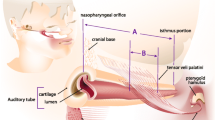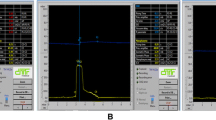Abstract
Although there are several factors affecting the pathogenesis of chronic otitis, the pathological process has not been entirely defined yet. One of the theories suggested for the development of middle ear diseases is tubal dysfunction. The aim of the study is to analyze the function of the tensor veli palatini (TVP) muscle electromyographically in chronic middle ear pathologies and to evaluate the role of this muscle in eustachian tube dysfunction and pathogenesis of associated middle ear diseases by comparing with the results of healthy individuals. Study design: A prospective, controlled, clinical trial. We enrolled 24 patients with chronic middle ear pathologies into our study and 18 controls without any previous ear problem. Electromyographic (EMG) needle was inserted into the TVP muscles in all patients transnasally. Functions of the TVP muscle were analyzed by using the amplitudes of the motor unit potential (MUP) and MUP durations detected on EMG. MUP amplitudes and MUP durations were compared statistically in all groups. When the mean MUP amplitudes and durations obtained from TVP muscles of all ears from the patient group were compared to the mean MUP amplitudes and durations obtained from healthy individuals, no statistically significant difference was observed between sick ears and control ears. Values obtained from the sick ears needed to be compared with mean values obtained from the control group separately, since absence of statistically significant difference cannot mean that we should ignore individual muscle dysfunction. The results we obtained from our study support that in the formation of different middle ear pathologies, myogenic defects in the eustachian tube have limited effects, except for existence of a predisposing factor like palate pathology. In all patients with chronic middle ear disease it is not appropriate to expect functional muscle dysfunction, however evaluation of TVP muscle function correctly may be helpful for bringing up the underlying possible muscle and nerve pathologies not in all patients.





Similar content being viewed by others
References
Alper CM, Tabari R, Seroky JT, Doyle WJ (1997) Magnetic resonance imaging of the development of otitis media with effusion caused by functional obstruction of the eustachian tube. Ann Otol Rhinol Laryngol 106:422–431
Bluestone CD (1998) Anatomy and physiology of the eustachian tube. In: Cummings CW, Fredrickson JM, Harker LE (eds). Otolaryngology head and neck surgery, 3rd edn. Mosby, St. Luis, 3003–3022
Bluestone CD (1971) Eustachian tube obstruction in the infant with cleft palate. Ann Otol Rhinol Laryngol 80:1–30
Bluestone CD, Doyle WJ (1988) Anatomy and physiology of eustachian tube and middle ear related to otitis media. J Allergy Clin Immunol 81: 997–1003
Buckingham RA (1970) Changes in the tympanic membrane with eustachian tube malfunction. Otolaryngol Clin North Am 3:15–44
Bylander A, Tjernstrom O, Ivarsson A, Andreasson L (1985) Eustachian tube function and its relation to middle ear pressure in children. Auris Nasus Larynx 12(suppl 1):43–45
Cantekin EI (1985) Eustachian tube function in children with tympanostomy tubes. Auris Nasus Larynx 12(suppl 1):46–48
Cantekin EI, Bluestone CD, Saez CA, Doyle WJ, Philips DC (1977) Normal and abnormal middle ear ventilation. Ann Otol Rhinol Laryngol Suppl 86:1–15
Cantekin EI, Doyle WJ, Bluestone CD (1983) Effect of levator veli palatini muscle excision on eustachian tube function. Arch Otolaryngol 109:281–284
Cantekin EI, Doyle WJ, Reichert TJ, Philips DC, Bluestone CD (1979) Dilation of eustachian tube by electrical stimulation of mandibuler nevre. Ann Otol Rhinol Laryngol 88:40–51
Cantekin EI, Phillips DC, Doyle WJ, Bluestone CD, Kimes KK (1980) Effect of surgical alterations of the tensor veli palatini muscle on eustachian tube function. Ann Otol Rhinol Laryngol Suppl 89:47–53
Casselbrant ML, Cantekin EI, Dirkmaat DC, Doyle WJ, Bluestone CD (1988) Experimental paralysis of tensor veli palatini muscle. Acta Otolaryngol 106:178–185
Doyle WJ (1984) Functional eustachian tube obstruction and otitis media in a primate model. A review. Acta Otolaryngol 414:52–57
Feldmann H (1996) The Eustachian tube and its role in the history of otology. Laryngorhinootologie 75:783–792
Holborow C (1970) Eustachian tube function. Changes in anatomy and function with age and the relationship of these changes to aural pathology. Arch Otolaryngol 92:624–626
Holborow C (1975) Eustachian tubal function: changes throughout childhood and neuro-muscular control. J Laryngol Otol 89:47–55
Honjo I, Kumazawa T, Honda. K, Shimojo S (1979) Electromyographic study of patients with dysfunction of the Eustachian tube. Arch Otorhinolaryngol 222:47–51
Honjo I, Okazaki N, Kumazawa T (1979) Experimental study of the eustachian tube function with regard to its related muscles. Acta Otolaryngol 87:84–89
Honjo I, Ushiro K, Nozoe T, Okazaki N (1983) Cineroentgenographic and electromyographic studies of eustachian tube function. Arch Otorhinolaryngol 238:63–67
Ishijima K, Sando I, Balaban CD, Miura M, Takasaki K (2002) Functional anatomy of levator veli palatini muscle and tensor veli palatini muscle in association with eustachian tube cartilage. Ann Otol Rhinol Laryngol 111:530–536
Kimura J (1989) Type of abnormality. In: Electrodiagnosis in diseases of nerve and muscle: principles and practice. F.A. Davis Co., Philedelphia, pp 249–274
Leuwer R, Henschel M, Sehhati-Chafai-Leuwer S, Hellner D, Eickhoff W (1999) A new aspect on the development of chronic middle ear diseases in patients with cleft palate. Laryngorhinootologie 78:115–119
Licameli GR (2002) The eustachian tube. Update on anatomy, development, and function. Otolaryngol Clin North Am 35:803–809
Linstrom CJ, Silverman CA, Rosen A, Meiteles LZ (2000) Eustachian tube endoscopy in patients with chronic ear disease. Laryngoscope 110:1884–1889
Matsune S, Sando I, Takahashi H (1991) Insertion of the tensor veli palatini muscle into the eustachian tube cartilage in cleft palate cases. Ann Otol Rhinol Laryngol 100:439–446
Penkner K, Kole W, Kainz J, Schied G, Lorenzoni M (2000) The function of tensor veli palatini muscles in patients with aural symptoms and temporomandibular disorder. An EMG study. J Oral Rehabil 27:344–348
Poe DS, Abou-Halawa A, Abdel-Razek O (2001) Analysis of the dysfunctional eustachian tube by video endoscopy. Otol Neurotol 22:590–595
Sadè J (1979) Secretory otitis media and its sequelae. Churchill Livingstone, New York
Su CY, Hsu SP, Chee CY (1993) Electromyographic study of tensor and levator veli palatini muscles in patients with nasopharyngeal carcinoma. Implications for eustachian tube dysfunction. Cancer 15(71):1193–1200
Su CY, Hsu SP, Chee EC (1993) Electromyographic recording of tensor and levator veli palatini muscles: a modified transnasal insertion method. Laryngoscope 103:459–462
Su CY, Hsu SP, Lui CC (1993) Computed tomography, magnetic resonance imaging, and electromyographic studies of tensor veli palatini muscles in patients with nasofarengeal carcinoma. Laryngoscope 103:673–678
Swarts JD, Bluestone CD (2003) Eustachian tube function in older children and adults with persistent otitis media. Int J Pediatr Otorhinolaryngol 67:853–859
Vacher C, Pavy B (2001) Palatal aponeurosis and insertion of the tensor muscle of the soft palate. An anatomic study and clinical applications. Rev Stomatol Chir Maxillofac 102:159–161
Author information
Authors and Affiliations
Corresponding author
Additional information
This manuscript was presented at the Annual 28th Turkish Otorhinolaryngology and Head & Neck Surgery Congress, Antalya, Turkey, May 21–26, 2005.
Rights and permissions
About this article
Cite this article
Sapci, T., Mercangoz, E., Evcimik, M.F. et al. The evaluation of the tensor veli palatini muscle function with electromyography in chronic middle ear diseases. Eur Arch Otorhinolaryngol 265, 271–278 (2008). https://doi.org/10.1007/s00405-007-0435-5
Received:
Accepted:
Published:
Issue Date:
DOI: https://doi.org/10.1007/s00405-007-0435-5




